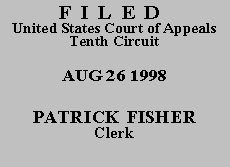

| UNITED STATES OF AMERICA,
Plaintiff-Appellee, v. EVAN RAY TISSNOLTHTOS, Defendant-Appellant. |
|
Defendant appeals from an order reimposing, on remand from this court, a vulnerable-victim enhancement of his sentence for aggravated assault. Our prior opinion noted that the only pertinent characteristic of the victim in the record was his age (71), an insufficient basis for inferring vulnerability. See United States v. Tissnolthtos, 115 F.3d 759, 762 (10th Cir. 1997). We held "particular findings of the actual victim's unusual vulnerability" were needed, and remanded "for the purpose of conducting this analysis." Id. While the task was complicated by the victim's death (of unrelated causes), the district court heard additional evidence and found the required vulnerability: "not only was the victim elderly, . . . but [he] was also physically impaired. . . . [He] had suffered a logging accident in the past that crushed his left ankle and hand. As a result of this accident, [he] walked with a limp and required the use of a cane. Additionally, his left hand was 'deformed' and disabled." District Court Order filed September 2, 1997. We review for clear error, Tissnolthtos, 115 F.3d at 761, and affirm.
A government agent who interviewed the victim within three months of the assault supplied all of the government's proof of vulnerability. Specifically, the agent (1) stated his personal observations of the noted physical impairments, and (2) related the victim's account of the prior logging accident. Defendant argues that each of these points of proof is flawed and that, consequently, the agent's testimony cannot substantiate the enhancement. With respect to the first, he insists that after-the-fact observations of the victim lack sufficient temporal relevance to the offense; as to the second, he objects that such hearsay lacks the reliability necessary to support a sentencing determination.
We need not resolve either of these isolated objections, however, because each point of proof, whatever its individual (in)sufficiency, supplied precisely what was missing in the other and, hence, together they provided an adequate evidentiary basis for the enhancement. The victim's facially plausible account of the origin of his impairments supported their existence prior to the assault, while, conversely, the agent's observation of the victim's physical injuries supplied the "minimal indicia of reliability" necessary for consideration of the hearsay account with which they were fully consistent, see United States v. Lopez, 100 F.3d 113, 120 (10th Cir. 1996). This being the only evidence on the issue, the district court properly found, by a preponderance, that defendant's victim was vulnerable. See generally United States v. Rice, 52 F.3d 843, 848 (10th Cir. 1995).
In his reply brief, defendant objects for the first time that the logging story is itself temporally problematic because the victim did not expressly state that the accident occurred before the offense.(1) This twice-waived argument, see Sac & Fox Nation v. Hanson, 47 F.3d 1061, 1063 (10th Cir. 1995) (issue not raised in district court ordinarily not considered on appeal); Lyons v. Jefferson Bank & Trust, 994 F.2d 716, 724 (10th Cir. 1993) (issue first raised in reply brief generally not considered on appeal), borders on the frivolous. It strains credulity to suggest that a man of seventy-one, hospitalized for an assault resulting in the loss of an eye, shortly thereafter secured employment in the logging industry. All credibility is lost with the further supposition that the man straightaway crushed his ankle and hand and then promptly engaged in the ambulatory interviews described by the government agent in his testimony.
The judgment of the United States District Court for the District of New Mexico is AFFIRMED.
Entered for the Court
Circuit Judge
*. This order and judgment is not binding precedent, except under the doctrines of law of the case, res judicata, and collateral estoppel. The court generally disfavors the citation of orders and judgments; nevertheless, an order and judgment may be cited under the terms and conditions of 10th Cir. R. 36.3.
1. Indeed, in his principal brief, defendant specifically referred to the logging story as evidence (albeit the only evidence) of the victim's physical impairments "at the time of the assault" or "before the assault." Opening Br. at 7, 9.